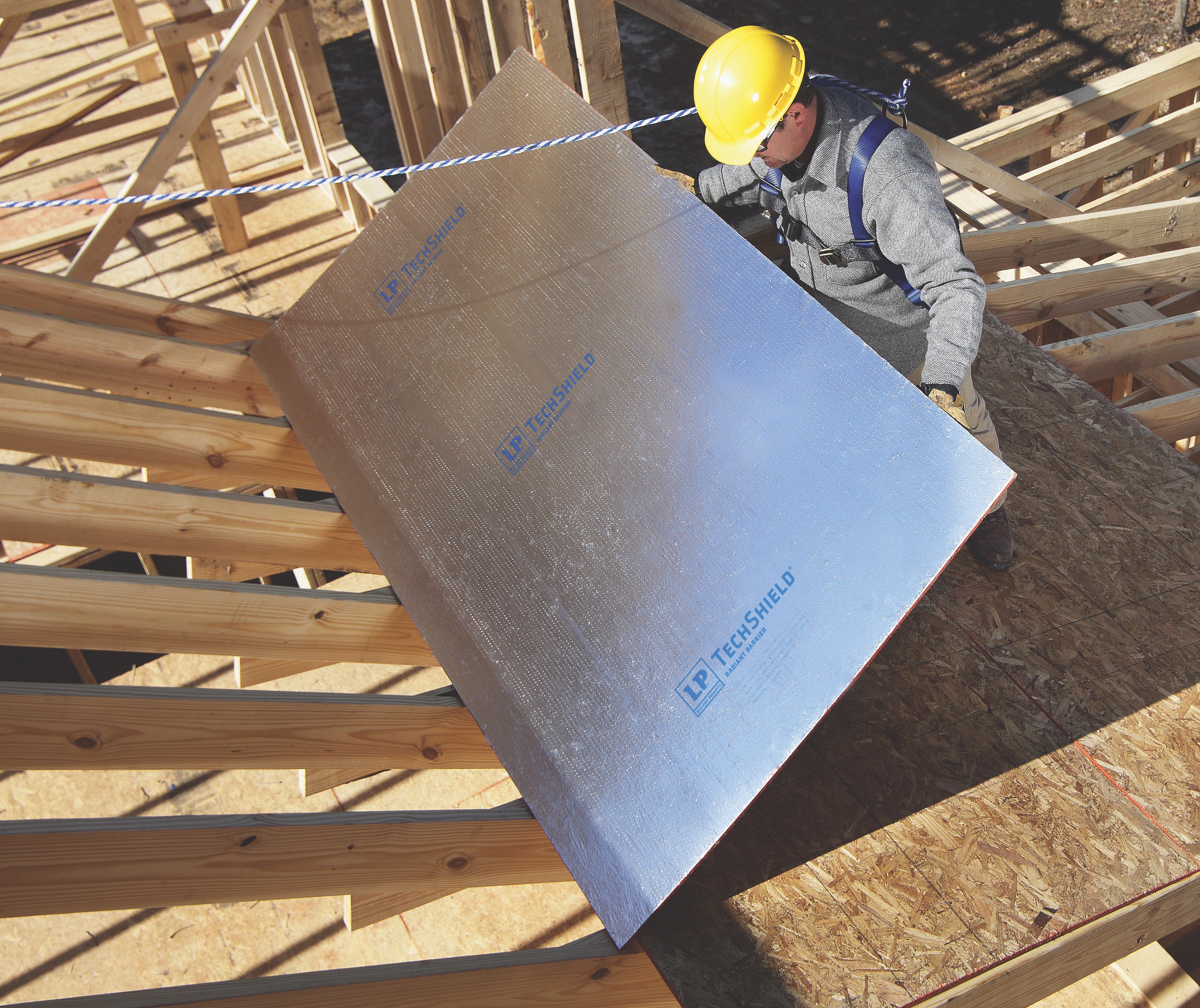It’s Getting Hot in Here: The Benefits Of LP® TechShield® Radiant Barrier
Radiant barriers have become very popular with efficiency-minded builders in the recent years. This is largely due to the fact that when installed properly, a radiant barrier can reduce the impact of summer heat and yield tangible savings in cooling costs of a home—a persuasive selling point when addressing potential homeowners. But how does radiant barrier work and what exactly are its effects?
Three Types of Heat Transfer
Let’s begin with a refresher on the basic laws of physics. Heat is always transferred from a hot to cold area by a combination of three mechanisms: conduction, convection and radiation. Radiant barrier technology focuses solely on the latter—and it does so by reducing the effects of the sun’s radiant energy.
How Radiant Barrier Works
With no radiant barrier in place the heat from the sun is absorbed by a home’s roof and re-radiated into the attic, thus raising the temperature of the living space underneath it. However, when radiant barrier sheathing is installed with its durable aluminum overlay facing down, it effectively blocks most of the radiant heat transfer—or, as is the case with LP® TechShield® Radiant Barrier, it blocks up to 97% of the radiant heat transfer from within the panel. In hotter climates, this can result in reductions of attic temperatures by up to 30° F.
Our “Secret Sauce”: VaporVents™ Technology
So what makes LP TechShield radiant barrier so effective? The answer to that question lies in the way the product is constructed. While many radiant barrier products available on the market feature reflective foil material placed on the surface of sheathing, only LP TechShield Radiant Barrier goes one step further with its VaporVents™ technology. The implementation of this technology occurs relatively late in the manufacturing process. After the face of the LP TechShield board is covered with an aluminum foil-like overlay, it then goes through our patented post-lamination process that creates numerous tiny incisions on the panel’s surfaces. This in turn allows the panel to “breathe” and allows moisture to escape.

A Difference Maker on The Jobsite
In the context of a build, the VaporVents technology allows the panels to dry more quickly during and after the home construction process—a significant advantage over competitive radiant barrier products. Simply stated, no other brand of radiant barrier sheathing offers this unique and important feature. Or as Ted Peters, Process/Product Development Manager at LP Building Solutions, puts it: “The VaporVents technology is the difference maker; it’s what makes LP TechShield the leading product in the entire category.”
Installation, Installation, Installation
Of course, proper installation always matters. While LP TechShield Radiant Barrier installs like conventional roof sheathing, requiring no additional labor or installation time, there are some crucial things to keep in mind in order to maximize its effectiveness—such as maintaining a small air gap between insulation and the roof deck. Also, it’s important to remember that any time radiant barrier comes in contact with rafters or insulation the heat transfer mode changes to conduction. Conduction can be reduced by using advanced framing (more spread-out rafters), which minimizes the contact areas and helps optimize overall performance.

The Tests Are In
LP TechShield Radiant Barrier is subject to annual verification by the RIMA International Verification Program, which was created to ensure that reflective products have fulfilled test requirements in accordance with the current applicable ASTM standards for North America. The RIMA verification process for LP TechShield panels includes rigorous testing in areas such as thermal emittance, water vapor transmission, and even corrosivity—all to ensure the highest product quality.
But even less scientific tests—like ones conducted in less extreme conditions—can easily prove the product’s effectiveness. Jordan Smith of Smith House Company recently conducted his own radiant barrier test on LP TechShield panels, using an infrared thermometer. Even on an overcast winter day in Texas with less radiant energy beating on the roof, the LP TechShield Radiant Barrier was able to reduce the attic temperature by about 10° F! Imagine what the difference would be in a middle of summer day with temperatures in the mid-90s.
Check out more about LP TechShield Radiant Barrier and view the product specs to start defending against heat and high energy bills.
Continue Reading
Resiliency Solutions
5 minIntroducing LP® SmartSide® ExpertFinish® Naturals Collection™: Nature-Inspired Beauty Meets Engineered Performance
We’re excited to introduce the LP® SmartSide® ExpertFinish® Naturals Collection™, a bold new addition to our trusted line of engineered wood siding and trim that delivers the warmth and beauty of nature with the advanced protection and performance builders and homeowners expect.
Labor Solutions
5 minChoosing the Right LP® Structural Solutions Product for Your Build
When it comes to building strong, reliable, and high-performing structures, the materials you choose matter. At LP Building Solutions, we understand that every project, whether it’s a single-family home or a multifamily development, requires structural components that meet your needs for strength, durability, and efficiency.
Sustainability Solutions
5 minBuilding a More Sustainable Future with LP Building Solutions
In today’s world, sustainability is no longer just a buzzword, it’s a blueprint for responsible living and smarter building. As the construction industry seeks ways to reduce its environmental footprint, LP Building Solutions is focused on providing innovative building materials for eco-conscious builders to help reshape what it means to build sustainably
News & Stories3 min
History of Partnership with Gary Sinise Foundation
The LP Foundation is a proud partner of the Gary Sinise Foundation, which supports wounded veterans in several ways. You can learn more about the LP Foundation here.